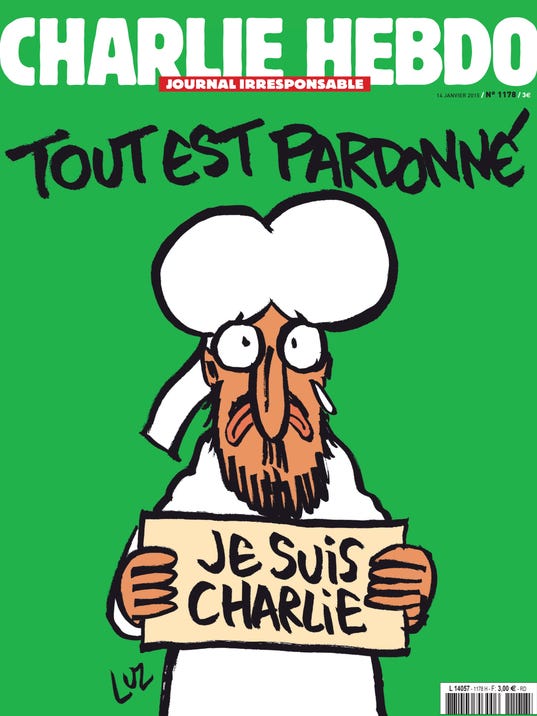Kudos to all the newspapers who had the guts to reprint the Charlie Hebdo cartoons on their front page. There were far too few of them. A couple of hours after the horrible attack in Paris, I was still hoping for a Charlie Effect: “If you kill someone for a cartoon, you will see it reprinted the next day in a thousand newspapers”. Except for a couple of courageous European newspapers, that hope proved forlorn. In the past week, a number of excuses have cropped up for not showing the images.
Why add fuel to the fire and provoke Muslims once again? Why distribute the very same cartoons for which so much blood has been shed already? Do you really want more victims on your conscience?
This line of reasoning sounds reasonable and conciliatory, but in it’s fact perverse and cowardly. We should not print the cartoons because they offend Muslims, but despite the fact that they do.
First and foremost, those cartoons are news. They were the direct occasion and motive for a horrible murderous raid, as the perpetrators themselves took care to point out. Newspaper readers have the right to know precisely which pencil strokes provoked so much hatred as to necessitate a suicidal blood-soaked revenge.
By choosing not to reprint the cartoons in any form, despite their overwhelming news value, newspapers are capitulating to terrorism. The demand of the terrorists, that their prophet shall be neither depicted nor mocked by anyone, ever, is thereby fulfilled.
But why insist on reprinting them everywhere? Those cartoons were spreading like wildfire on social media anyway. For anyone who wants to see them, they are just a few clicks away. We can defend other people’s right to blaspheme without exercising that right ourselves. Freedom of expression is a right, not a duty. As The Guardian wrote in a collective editorial: “defending the right of someone to say whatever they like does not oblige you to repeat their words.”
This attitude is a more subtle form of cowardice. If just a few newspapers have the courage to show the cartoons, only they will bear the brunt of religious extremism. The fewer people show them, the higher the hazard for the courageous. And if no-one shares them, the terrorists have won.
The fear of newspaper editors to show the cartoons is understandable. The Hamburger Morgenpost had its offices firebombed after reprinting them. The Turkish secular newspaper CumhuriyetDaily has received countless death threats after announcing they would reprint some of the cartoons. In the end, the actual blasphemous material (the depiction of the prophet) ended up as a small black-and-white image in the column section.
Vous êtes Charlie?More people should’ve been Charlie in 2006, when the satirical magazine was among the few having the guts to reprint the Danish cartoons. Back then, this was widely condemned as an act of needless “provocation”, and got the magazine involved in a lawsuit for racism (a preposterous accusation). Because of the cowardice of other media, a small and vulnerable satirical magazine became the lonely focal point of all religious hatred.
What we needed back then, and still need, is an avalanche of cartoons depicting the prophet. Not to deliberately offend devout Muslims, but to desensitize the extremists. That strategy proved effective with other religions, who have learned the hard way that, in a free society, anyone has the right to criticize and mock their beliefs. Sadly, even today, most major American news outlets refuse to reprint the cartoons, out of misplaced ‘respect’ for religious sensibilities. Sure they defend the right to blaspheme. It’s just that they’d rather have someone else standing in the firing line.
But how can you force anyone to endorse offensive and racist cartoons? There is no duty to offend. This call for ‘solidarity’ amounts to browbeating everyone into further insulting an already oppressed religious minority. That is itself an infringement of free speech.
Reprinting a cartoon out of solidarity with the victims of a hate crime, as a way of affirming their right to have published it, does not mean that you endorse its message. No-one forces anyone to like the Charlie Hebdo cartoons. If you are a journalist and you think a cartoon is highly offensive, you would still reprint it if newsworthy, if only to show how offensive it is. When Gerald Scarfe published a cartoon of Benjamin Netanyahu in the Sunday Times last year, reminiscent of the ancient blood libel charge, Jewish newspapers also reprinted the cartoon. Were they therefore endorsing its anti-Semitic message? Of course not. The cartoon was just news, and they were discussing it in the only sensible way: by showing it.
By the accounts of some apologists who refuse to show them, you are almost led to believe that the avenged Charlie Hebdo cartoons were vile, racist, xenophobic drivel. In order to rationalize their own cowardice in the face of religious extremism, many newspapers now pretend that the drawings are so terribly offensive that it would hurt their readers’ eyes to see them. This is to exaggerate the sensibilities of even most devout Muslims. The charge of racism is a particularly ridiculous one, given the explicitly left-wing, anti-racist orientation of Charlie Hebdo. It is also completely irrelevant, as there is no indication at all that the Paris attacks were in retaliation for alleged racism. The murderers, as they made abundantly clear at the crime scene, were avenging the prophet Mohammed, not any alleged Arab “race” (they did not even share the same ethnic background).
This is one of the persistent ironies of religious apologists on the Left: some would rather slander their own (dead) allies as “racists” than incriminate a certain opium of the people.
